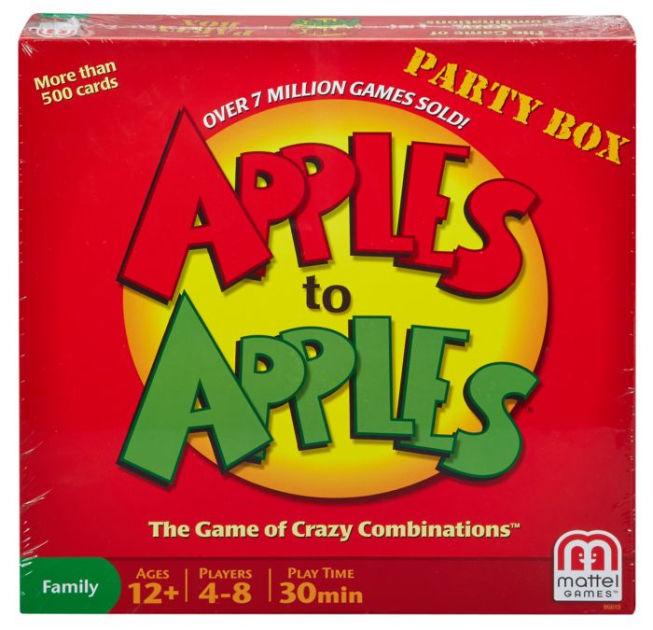Introduction
Apples to Apples is a judging game from Mattel. It is a card game using physical cards. The game creators recommend that it should be played by 4-8 players who are 12+ in age. The target audience is suitable for younger players and could be played in a family gathering setting. The cards feature relatively innocuous humor.

Formal Elements
Here is an overview of the important formal elements in Apples to Apples. The objective of the game is to collect the most cards. Players can collect a card by putting down a red card that best matches a green prompt card as judged by a moderator each round. The game features player vs. player interaction, with players competing against other players to put down the card the most fitting card. The cards serve as resources. Each player has five red cards in their hand at one time and can only select from their available cards, creating some scarcity. Each player also aims to collect cards if they win a round, so the cards also act as a type of utility. There is also conflict present in the game. The player is competing against components who may have better fitting cards. Another obstacle is the moderator, since knowing how the moderator thinks could be helpful in selecting a card. Regarding the outcome of the game, Apples to Apples does not have a solid place to end. Players can play until the cards run out or players feel like stopping. At that point, players can compare their success by seeing the number of cards they collected. The main objective of the game is exploration because although there is some element of competition, the focus is to create a funny and entertaining experience through the judging of cards. The procedure of the game directs the game flow. First, players each draw five red cards, and then the selected moderator shows all of the players a category card. Next, all of the players except for the moderator place down a red card in their hand. When everyone is ready, the moderator judges the best fitting card, and the player who placed that card gets to keep a card as an indicator of winning that round. Players then each draw another red card. The next person in the sequence of players becomes the moderator, and the players then move on to the next round. Some rules of the game include only being able to have five red cards at a time, having the moderator be the judge, and not being able to see opponents’ cards.

Comparison to Other Games
Apples to Apples is similar to other judging games such as Cards Against Humanity. These two games have almost identical mechanics but feature different premises. Apples to Apples uses more innocuous humor while Cards Against Humanity uses more adult, offensive, or politically incorrect types of humor. While the mechanics and general flow of the game are the same, the difference in the audience can lead to a different play experience with different intended target audiences. Players may feel more vulnerable when playing Cards Against Humanity.
Another similar game is Wing it, also having very similar mechanics. However, instead of using category cards and matching words/phrases, Wing it uses cards with the beginning of a story written on them and cards containing elements players can use to complete the story. Wing it enables players to incorporate storytelling into the game. This can change the pacing and feel of the game since storytelling can be slower.
Type of Fun
The main type of fun in Apples to Apples is expression. A core part of the game is to put down cards that make a humorous result. The creativity of the players is what makes the game enjoyable. Although there is somewhat of an element of competition, the game stands out by allowing players to express themselves and demonstrate their sense of humor. When playing this game, I often forgot about the scoring system and instead focused on enjoying the experience of both expressing myself and laughing along with other players’ answers.

Vulnerability
Apples to Apples does not require players to get very vulnerable. The subject matter on the cards can appeal to a large range of people and the content is designed to be not very controversial. It is possible to play the game with strangers since the players don’t need to know a lot about the other players to participate. The game also leaves space for discussion, so it could be helpful in starting conversations. However, the game can also become more fun if players are more familiar with each other and understand each other’s sense of humor better. Ultimately, it does not require vulnerability but also leaves space for increased vulnerability if players want it.


